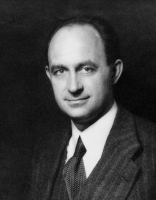










Enrico Fermi(1901-1954), Italian-born American scientist who was one of the chief architects of the nuclear age. He developed the mathematical statistics required to clarify a large class of subatomic phenomena, explored nuclear transformations caused by neutrons, and directed the first controlled chain reaction involving nuclear fission. He was awarded the 1938 Nobel Prize for Physics, and the Enrico Fermi Award of the U.S. Department of Energy is given in his honour. Fermilab, the National Accelerator Laboratory, in Illinois, is named for him, as is fermium, element number 100.
Early life and education
Fermi’s father, Alberto Fermi, was a chief inspector of the government railways; his mother was Ida de Gattis, a schoolteacher. In 1918 Enrico Fermi won a scholarship to the University of Pisa’s distinguished Scuola Normale Superiore, where his knowledge of recent physics benefited even the professors. After receiving a doctorate in 1922, Fermi used fellowships from the Italian Ministry of Public Instruction and the Rockefeller Foundation to study in Germany under Max Born, at the University of Göttingen, and in the Netherlands under Paul Ehrenfest, at the State University of Leiden.
Physics
Soon, Enrico Fermi's physics career and personal life flourished. In 1928, he married Laura Capon, the daughter of a respected Jewish family in Rome. They had one son, Giulio, and a daughter named Nella. Professionally, Fermi was elected professor of theoretical physics at the University of Rome.
In 1934, Fermi began his most important work with the atom, discovering that nuclear transformation could occur in nearly every element. One of the elements' atoms he split was uranium. This work led to the discovery of slowing down neutrons, which led to nuclear fission and the production of new elements beyond the traditional Periodic Table.
In 1938, Fermi was awarded the Nobel Prize in Physics "for his work with artificial radioactivity produced by neutrons, and for nuclear reactions brought about by slow neutrons." The honor was a life-saver for the Fermi family. Fascist Italy had just instituted anti-Jewish laws. The award ceremony in Stockholm, Sweden, gave the family the opportunity to travel out of Italy and escape to America.
Life in America
Situated safely in the United States, in 1939, Fermi was appointed professor of physics at New York's Columbia University. While there, Fermi discovered that if uranium neutrons were emitted into fissioning uranium, they could split other uranium atoms, setting off a chain reaction that would release enormous amounts of energy. His experiments led to the first controlled nuclear chain reaction in Chicago, on December 2, 1942, under Chicago's athletic stadium.
Subsequently, during World War II, Fermi became one of the principal leaders on the Manhattan Project, which focused on the development of the atomic bomb. To further his commitment to his new country, Fermi and his wife became American citizens in 1944.
After the war, Enrico Fermi was appointed to the General Advisory Committee for the Atomic Energy Commission. In October 1949, the commission met to discuss the development of the hydrogen bomb. Fermi was appalled at the prospect, however, and later co-authored an addendum to the committee's report condemning the H-bomb in the harshest language. When President Harry S. Truman ordered the development of the bomb—ignoring Fermi's and others' warnings—Fermi returned to Los Alamos, New Mexico, to help with the calculations, hoping to prove that making a superbomb wasn't possible.
Final Years
Enrico Fermi continued his work at the Institute for Nuclear Studies at the University of Chicago, where he turned his attention to high-energy physics, and led investigations into the origin of cosmic rays and theories on the fantastic energies present in cosmic ray particles.
By 1954, Fermi had contacted incurable stomach cancer, and spent the remaining months of his life in Chicago, undergoing various medical procedures. He died in his sleep on November, 28, 1954, at his home in Chicago, Illinois.
Matteucci Medal (1926)
Nobel Prize (1938)
Hughes Medal (1942)
Medal for Merit (1946)
Franklin Medal (1947)
ForMemRS (1950)
Barnard Medal for Meritorious Service to Science (1950)
Rumford Prize (1953)
Max Planck Medal (1954)